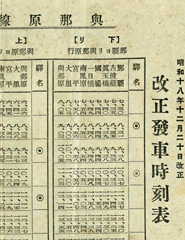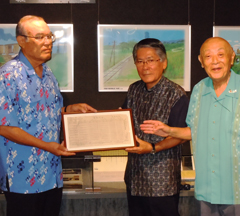Timetable of former Okinawa Light Rail found in diary of late songwriter Nakamoto

The timetable published by the Okinawa Prefecture Light Rail Office in 1943.
April 21, 2012 Ryukyu Shimpo
A timetable published by the Okinawa Prefecture Light Rail Office in 1943 was found in Gushichan, Yaese. Kaoru Nakamoto found the timetable inside his late father Minoru Nakamoto’s diary when he was cleaning up his father’s belongings. In the diary, there was also a detailed description of the times, explaining how his father and the family escaped during the Battle of Okinawa.
There was a note written on April 1, 1945, just before the American troops landed in Okinawa. Nakamoto gave a copy of the diary to Ryoji Nakayoshi the president of the Okinawa Urban Monorail Inc., saying, “The diary lets us know how the light rail worked for the benefit of the people of Okinawa before the war.” Officials comment that very few timetables have been found, and that this is an item of historical significance.
The copy will be displayed in the exhibition hall of Okinawa Urban Monorail and the original diary will be donated to the Museum of History and Folklore in Gushichan, Yaese.

The late Minoru Nakamoto kept a diary using the space on a timetable. He wrote how his family fled from Gushichan to Kin.
Minoru Nakamoto is also famous as a songwriter. He wrote the lyrics for Ashimijibushi, a folk song about the joy of work, for which Choho Miyara composed the music. When he was working as a postmaster of Gushichan he bought the timetable, which contained timetables of three rail-lines: Naha to Itoman, Yonabaru, and Kadena, and his local station, Kochinda, had a red circle around it.
The diary started from March 25, 1945, with the comment, “Air raids last for three days, we left our house in the evening,” and finished on April 1, “It is a fine day. Air raids have lasted for ten days until today.” His family members left the house in Gushichan and were captured in Kin, where they became prisoners of war.
In December 1944, the ammunition-laden railway carriage exploded near the Inamine Station in Inamine, Ozato, in Nanjo, killing more than 200 people including schoolgirls. One of the survivors of the accident, 83 year-old Yoshiko Itokazu, attended the ceremony. Reflecting on her life as a high school student in those times, she said, “The light rail was used by the military from 1944, so that must be the last regular timetable. I am glad to hear that it was found.”

Kaoru Nakamoto (second on the left) donated a copy of the light rail timetable to Ryoji Nakayoshi (left), the president of Okinawa Urban Monorail Inc. On April 20, 2012 at the Yui Rail Exhibition Hall.
According to essayist Yutaka Hajime, who is an authority on the light rail, the railway was used by Imperial Japanese Army for military purposes until some time during the Battle of Okinawa. 1943 was the last period for public use, so the timetable was published around that time. Hajime said, “This is not just a series of numbers, it is tells us about history, climate and traces of human activity.”
(English translation by T&CT, Shinako Oyakawa and Mark Ealey)
Previous Article:Okinawan restaurant in Orange County
Next Article:Okinawa Education Office asks high schools to teach about the reversion of Okinawa
[Similar Articles]
- Collector acquires tickets and commuter passes of a street-car that operated in Okinawa in the prewar period
- Monorail featuring a picture of Shuri Castle runs
- Now operational: Monorail extension into Urasoe adds four new stations
- Okinawa Rail’s eggs found in the belly of Habu snake
- Yambaru kuina returned to forest
 Webcam(Kokusai Street)
Webcam(Kokusai Street)


